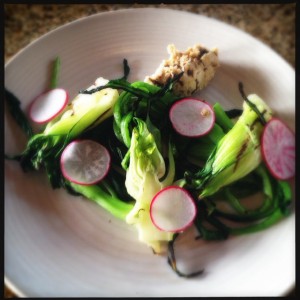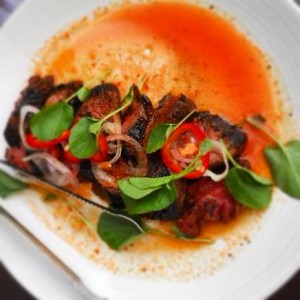MiGRANT: Around the World in Eight Plates (Maui Now)
Your mission, should you choose to accept it, is to elevate the beloved cuisine of your childhood.
You may select any two items for transmutation into fine dining fodder, but it is essential that you also include:
- Peanut Butter and Jelly sandwiches
- Spaghetti-Os
- Rice Krispie Treats
- Oscar Meyer Hotdogs
You have forty-eight hours to perform culinary witchcraft and present your results.
As always, if you flub this up, the Secretary, the Admin Assistant and your very own mother will disavow all knowledge of your actions.
This message will self-destruct in five seconds.
***
Can this seemingly impossible mission be completed, or – more importantly – should it be?
Ultimately that’s the question we began to ponder while dining at Chef Sheldon Simeon’s MiGRANT restaurant.
 (That and “why is the ‘i’ lowercase and all the other letters capitalized? Is he trying to tell us something? Is it an anagram? ATM Grin? Mgr. Tina?”)
(That and “why is the ‘i’ lowercase and all the other letters capitalized? Is he trying to tell us something? Is it an anagram? ATM Grin? Mgr. Tina?”)
Anywho, dining at MiGRANT is like a real-life version of Being John Malkovich. You’re suddenly in the head of the man the Hollywood Reporter called a “Hawaiian Care Bear” and chewing on his food memories.
Well, maybe not quite that freaky, but it feels to us like the chef is offering a taste – often an intimate one – of his own background, heritage and preferences.
It’s a cool idea that’s occasionally hard to grasp.
Take the “Bottom of the Plate Lunch” ($8), described as shaved Kula cabbage, rendered ribeye schmaltz and warm kalbi.
Sounds promising, but prepare to feel a bit baffled when the giant bowl of raw shredded cabbage is brought to the table.
Yep.
Raw. Shredded. Cabbage.
At least two full cups of it.
It’s then topped with a warm savory jus made from condensed Korean-style kalbi drippings
Bon appetit.
It’s crunchy, cabbage-y and probably good for your digestion or something… But what the heck?
We left confused.
On a subsequent visit, we had a different waiter. While spieling the menu, he commented that the dish is “basically raw cabbage.”
Indeed.
However, he didn’t stop there.
Smiling, he disclosed that it’s actually an offering very near and dear to Chef’s heart.
“He started out as a dishwasher and every night he would have a plate lunch of kalbi ribs,” the waiter explained.
“He’d bring home the leftovers and – you know how they always put cabbage on the bottom of a plate lunch? – he started to realize that was his favorite part: the cabbage soaked in the kalbi juices.”
Suddenly the dish becomes less unfathomable and almost an invitation into Chef Simeon’s home, his kitchen, his life.
“Come my house. Eat.”
On a plate.
We get it now.
It’s supposed to evoke leftovers… On purpose.
But here’s the problem: you cannot glean this from the menu nor the food itself. And we’re hard pressed to say that the dish works without the charming story.
Therein lies the dilemma that is much of MiGRANT’s cuisine: it’s a trip down memory lane through memory banks you know nothing about and often into flavor profiles – Filipino, in particular – that are quite unfamiliar to the average resort guest.
In short, there are a lot of “what is this?” moments and that’s both a good thing and perhaps a bit alienating at the same time.
Regardless, one dish we imagine pretty much everyone can get down on is the “KFC” Korean Fried Chicken Wings ($19).
The large wings are breaded and crisply fried. Well-seasoned with a kick, they’re nothing like that other KFC. In a good way.
Tempering the spices are the cooling the waters of the sweet peanut dipping sauce on which the wings are plated.
Unique, yet approachable. We dig it.
Same can be said of the Brick Oven Blistered Shishito Peppers ($11).
Spanish tapas fanatics will recognize these as the kissing cousin of Pimientos de Padron; mild, fruity peppers that are charred, salted and unapologetically served with a Hidden Valley Ranch-based sauce.
Wait. Did we say “mild and fruity”?
That’s true 80 to 90% of the time, but be prepared for the eye-watering heat of the occasional rebel.
You’ll be begging for some cooling ranch dip then.
The Hand Cut Fat Chow Funn ($16) boasts house-made noodles. Thick and meaty, they are delightful.
Seared and topped with tomatoes, red onions, pipinola (a.k.a chayote or mirliton) shoots, Parmesan cheese and pork, the already-exotic combination arrives in a light broth we can only describe as funky.
Is that fish sauce in there?
The flavors are assertive – maybe too much so for many palates.
Bottom line: if you head into this dish expecting a Americanized Chinese-style noodle dish, well, think again.
Speaking of noodles, we also tried the Pancit ($16).
Although there is no set recipe, a typical home version might include cabbage, sausage, shrimp, pork rinds and some form of citrus. A traditional Filipino comfort food, it’s a dish that’s hard to fancify.
The chef tries, however, and the ingredients are top-notch – black tiger shrimp, pork belly chunks, garlic chives and half of a fresh calamansi citrus.
Despite the seeming potential, the primary flavors we picked up were fishy and garlicky. Depending upon one’s expectations, we are not sure most folks will cotton to this.
Our advice?
Unless you’re already familiar with Filipino food, approach this dish – if not the entire menu – with an open mind and a wanderlust for the unfamiliar.
Nevertheless, should your taste buds start begging for mercy, consider the Choy Choi ($10).
Downright plain in comparison; young, lightly steamed bok choy and choi sum stalks are topped with thin radish slices. Visually striking, the dish offers a refreshing contrast to much of the powerfully seasoned menu.
Case in point, the Hibachi Hanger Steak ($29), also by far our favorite.
Plated over a layer of Vietnamese nuoc cham (typically made with water, lime juice, sugar and fish sauce), the meat is charred on the outside and juicy inside.
It’s then topped with red jalapeno slices, fresh watercress, and lightly pickled, paper-thin shallot slices. It’s the food equivalent of the Village People.
Salty, sour, sweet, smoky, and spicy (cowboy, cop, construction worker, biker and Native American): Everybody was invited and they all showed up.
I’ve got to be a macho!
In contrast, the Tocino, Filipino Sweet Pork ($16) didn’t do much for us.
The Sprite-marinated pork shoulder was a bit dry, and we found the flavor of the accompanying pickled onions too dominant.
But that’s just us.
And more than once we couldn’t help but wonder if our own relative unfamiliarity with Filipino cuisine might be to blame for the disconnect.
There was sometimes so much going on that the experience moved quickly from intriguing to overwhelming.
If the chef perhaps offered a more novice-geared tasting menu or recommended a progression of courses for those unfamiliar with the vast lineup of exotic ingredients, we suspect the average Joe – not to mention the average Marriott guest – would find this more an adventure than a workout.
Alien, yet accessible: if it’s possible, we can hardly wait.







